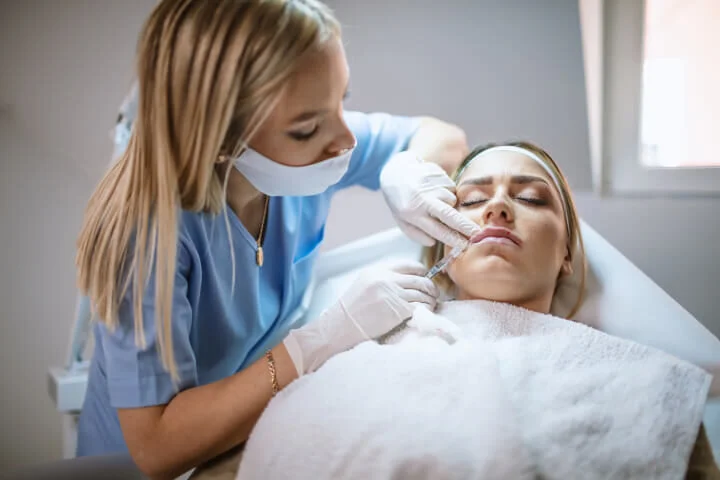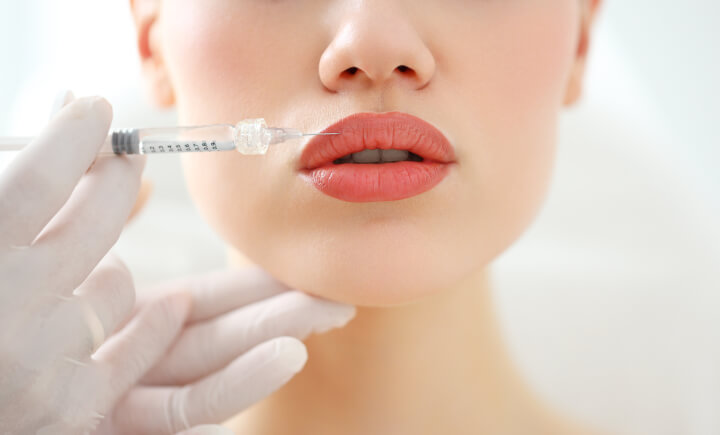Injectable vs Non-Injectable Dermal Fillers: Which is Better?

Facial muscles, skin, fat, and bone are the four basic structural units of the face. Most aging signs are due to volume loss in such structures, and dermal filler treatment may be the solution. Jawline retraction, lowering of the nose, and sagging cheekbones loss can result from age-related facial bone loss—the facial volume and muscle suppleness decrease while aging.
So which is the better option between injectable and non-injectable dermal fillers? While both injectable and non-injectable procedures are effective, the former works better for those who need specific parts of their bodies to be reached, while the latter works better for those who have phobias with syringes and needles. When administered, they both rest in the dermis of the skin but in distinct ways. Both therapies help with improving your look, but have different effects on the areas that you’re targeting.
What is your perfect cosmetic filler? Whether in your lips, cheeks, or anywhere else, our providers know exactly how to make you look your best. Call us today to learn more.
Comparison of Injectable and Non-Injectable Dermal Fillers
The non-injectable therapy generates almost no discomfort; most patients feel pressure instead of pain. All procedures are non-invasive and don’t involve needles, so there is no need for anesthetic or fillers with lidocaine. Anyone with an allergy to lidocaine or a fear of needles can benefit from the procedure.
It takes roughly 30 minutes to complete the treatment without using syringes or anesthesia. The therapy offers a natural, youthful appearance and allows patients to resume their typical day. Swelling is present; however, infection rates are dramatically reduced because no needles are employed, allowing patients to continue their usual tasks.
The disadvantage of the no-needle filler is that it cannot cure all regions. Lips, nasolabial folds, marionette lines, and chin dimples are the only areas that non-injectable facial filler can manage.
This treatment is best suited for vertical lip lines, smile lines, and the appearance of wrinkles around the corners of the mouth and lip volume or any contour imbalance. This cosmetic treatment is perfect for people who consider lip augmentation and enhance their facial features to achieve a more natural appearance.
On the other hand, plastic surgeons can inject the injectable dermal filler into any part of the face for facial contours and sculpting. Monodensified fillers can shape the cheekbones, jawline, nose, and vermillion border, for instance.
Injectable fillers are suitable for even more delicate tasks to add structure; it is a better option for people who want to modify their natural features and treat facial wrinkles. People can also prefer longer-lasting fillers that last for up to 24 months after injection. It means individuals don’t need follow-up injections for their injectable wrinkle filler.
Even though injectables increase the risk of adverse effects, individuals must follow the aftercare instructions to prevent issues. Injectables do necessitate numbing to avoid pain during injection. A qualified provider may use adjunct lidocaine, which is inappropriate for those with allergic reactions.
Injectable treatment means higher accuracy and a prolonged procedure time of about 60 minutes based on the target area. The duration of cosmetic procedures may increase for patients with more than one treatment area.
Complimentary consultations are always suggested for both treatments so that the dermal filler provider can tailor the ideal aesthetic procedures for every patient. The average cost for injectables ranges from $180 to $300 per vial, while non-injectables cost ranges from $140 to $180 per vial.
Learn More: Bolus Injection vs Serial Puncture Technique for Dermal Fillers
Advantages and Risks of Non-Injectable and Injectable Fillers
While types of hyaluronic acid dermal filler products are commonly referred to as “wrinkle fillers,” they are capable of so much more than just smoothing out severe wrinkles. Though it’s important to note that hyaluronic acid fillers are mainly used to target wrinkles.Here are some of the most prevalent concerns that hyaluronic acid dermal fillers can help with:
- Dynamic lines
- Tear trough
- Volume increase of temples or sunken cheeks.
- Reduction of the appearance of vertical lip lines.
- Thinning lips
- Frown lines
- Static wrinkles
- Dynamic wrinkles
- Improvement of facial structure and symmetry
The hyaluronic acid filler softens and plumps deeper lines, resulting in a very natural appearance. The beauty of this filler and method is that it can create a delicate enhancement that is not visible to other people. Patients are delighted with the results, and they won’t have to worry about anyone noticing they had something done.
There are risks associated with using dermal fillers, just as with any surgical procedure. It is crucial to know their limitations and potential side effects. Any dermal filler can have transitory, long-lasting, or common side effects. The majority of dermal filler complications happen immediately after injection and usually resolve within a few weeks.
Inflammation and pain from hand treatment can last for a month or more. Adverse reactions from dermal filler injections can emerge weeks, months, or years later in certain instances.
The most troubling risk of using dermal fillers is unintended infusion into a blood vessel, resulting in obstructed blood vessels and poor blood flow to body tissue.
Although the odds of that happening are small, the consequences can be severe and even persistent if it does. Necrosis (tissue death), eyesight abnormalities, vision loss, and stroke have all been mentioned as complications. Patients must be evaluated for allergies before using a type of filler made with specific components, particularly animal-derived resources [rooster comb or cow (bovine collagen)].
The FDA-approved usage of injectables is associated with multiple risks. The risks involved with unauthorized hyaluronic acid filler applications or the use of unsanctioned products are unknown.
Among the most common dangers are:
- Redness
- Bruising
- Tenderness
- Pain
- Swelling
- Itching or rash
- Difficulty in carrying out activities (only noticed when inserted into the back of the hand)
The unusual risks are:
- Raised bumps in or underneath the skin (granulomas or nodules) which may require infusions, oral antibiotics, or surgical removal
- Infection
- Wounds that are open or draining
- Injection site sores
- Allergic response
- Death of tissue (necrosis)
The FDA has also received reports of the following rare risks:
- Anaphylactic shock (severe allergy) necessitates prompt urgent medical treatment.
- Damage to the blood supply due to an unintentional infusion into a blood vessel, leading to necrosis (tissue death), vision impairments such as blindness, or stroke.
- Migration (movement of filler substance from the site of injection)
- Filler material leakage or burst at the injection site or through the skin (may result from an infection or tissue reaction)
- The emergence of long-term hard nodules
- Death
It is possible for individuals who want to remove their fillers or lower the dosage because of side effects through surgery or injections. Such procedures come with their own set of risks. Doctors should inform the patients that removing the filler material, particularly “permanent” dermal fillers or injectables made of substances that do not generally resorb, like hyaluronic acid, may be challenging or impossible.
Read More: Which Dermal Filler Lasts the Longest?
Other Alternatives for Injection Based Fillers
Some things are disqualifiers in the quest for flawless skin. For others, anything to do with injections is acceptable. These techniques are frequently cost-efficient than paying for a round of infusions, but individuals must be patient and consistent for them to work. People should also remember that many other methods will not produce the same results as injections.
Retinol. It is regarded as the precious standard wrinkle-reducer. It’s often seen in over-the-counter wrinkle creams. Like most widely known ingredients, many are preferable to others, but they won’t cost too much.
FaceXercise. While the title indicates exercise, this involves a blend of cupping and massage, referred to as facial muscle exercise.
Peeling agent. These are less invasive than needles, but they can be uncomfortable. The top skin layer is sloughed off with a chemical peel. The layer beneath is younger-looking and smoother. A peel can be of different depths or degrees based on a person’s needs, but they all result in sensitive skin.
Supplements. There are many alternatives for healthier-looking hair, nails, and skin, whether a person chooses an increased vitamin E or biotin or vitamins such as collagen. Avoid excessive supplements and always consult the doctor when experiencing any side effects.
Facial microcurrent. An expert will use a device to transmit electrical impulses to the nerves, stimulating them and providing a natural lift to the skin. One study of 30 women discovered that microcurrents performed best on the brow area and that the effects lasted for 30 days.
Stress-relief practices. People’s expression often represents the internal imbalance. If stress is gradually taking a toll on the face and skin, stress relief and deep breaths may be a better option than receiving needles in the face.
Gua sha. It’s a Chinese word that means “good luck.” This device, like jade rollers, is based on ancient Chinese medicine. The massage tool removes skin and increases blood flow in soft tissues. Although people can use it all over the body, the face is treated with a milder method.
Jade roller. This jade stone tool has been shown to decrease puffiness, fine lines, and tear troughs with consistent use. Rose quartz is another option for rollers for the face.
Ampoules or serums. Like vitamin E, a vitamin is generally highlighted in skincare products or supercharged serums, defined as ampoules. A serum can be used twice daily, whereas an ampoule can be used as additional care, indulging time treatment.
Yoga for the face. Why not do yoga for the face as well as the body? This exercise claims to give an impression of tucks and lifts by enhancing tone and relaxation through a sequence of facial gestures. As with any exercise, it requires time investment and is not immediate.
Read More: Voluma Filler: Facelift Without Surgery
Book a Consultation With aNu Aesthetics to Know the Best Dermal Filler for You

aNu Aesthetics is home to licensed cosmetic surgeons and highly trained staff for your beauty concerns. The experts in our team will guide you every step of the way to achieve your dream look: they consider your preferences in terms of tools and methods for getting dermal fillers, and give you tests and advice to ensure great results. Let us help you achieve your aesthetic goals and contact us today.
What is your perfect cosmetic filler? Whether in your lips, cheeks, or anywhere else, our providers know exactly how to make you look your best. Call us today to learn more.